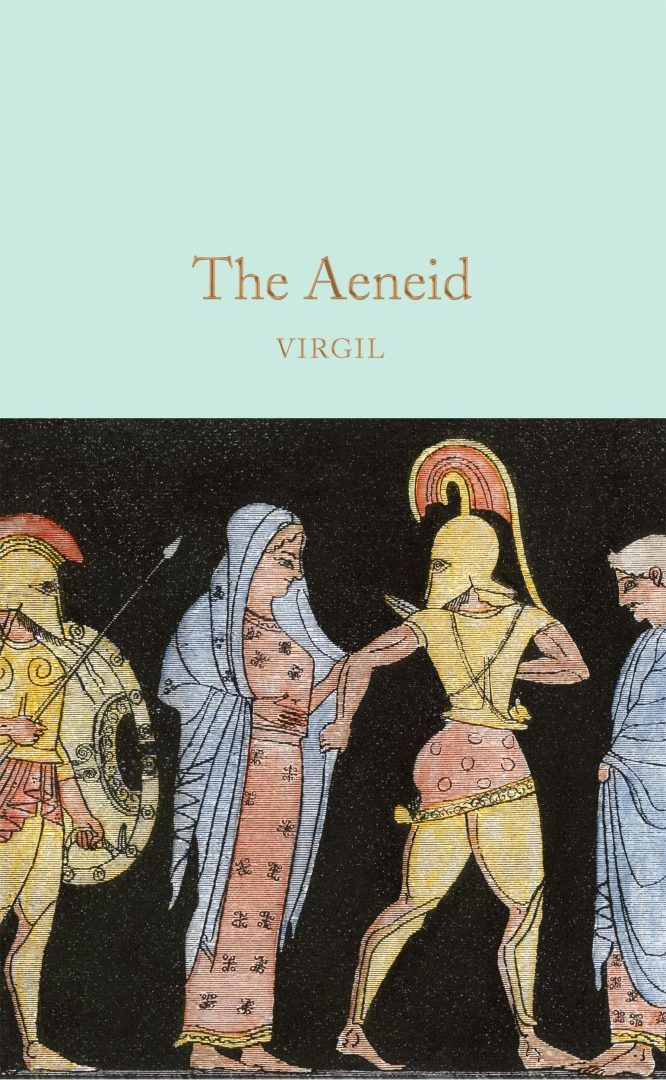Rome’s Sacred Epic: Destiny, Duty, and the Price of Empire
Table of Contents
From Troy to Rome: The Epic That Forged a Civilization
The Aeneid is not merely a poem—it is a national scripture, a mythic charter for Roman identity and destiny. Commissioned by Augustus Caesar and written by Publius Vergilius Maro (Virgil) between 29 and 19 BCE, the Aeneid blends the high artistry of Homer with Roman political theology. It enshrines pietas—duty to gods, family, and country—as the supreme virtue, embodied in the Trojan hero Aeneas, ancestor of Rome.
This is imperial propaganda wrapped in Homeric silk, yet never cynical. The poem’s emotional depth, narrative architecture, and moral gravity transcend its political purpose.
Structure and Synopsis
The Aeneid spans 12 books, consciously mirroring Homer’s Iliad and Odyssey:
- Books 1–6: Aeneas’ wanderings after the fall of Troy—storms, shipwreck, the doomed love of Dido, and a descent into the Underworld.
- Books 7–12: The wars in Italy—Aeneas’ battles against the Latins, especially Turnus, culminating in a brutal victory.
Throughout, Aeneas is guided (and tormented) by the gods, driven by destiny to found a people “whose dominion shall have no end.”
Key Themes
Pietas vs. Furor
- The central ethical tension. Pietas is loyalty to divine will, while furor is chaotic passion and rage. Aeneas must suppress his own desires (and others’) to fulfill fate. Even love—such as his affair with Dido—must be sacrificed.
Destiny and Empire
- Rome’s rise is preordained. The poem celebrates imperium sine fine—“empire without end”—but also interrogates its human cost. The Aeneid asks: What does it mean to be chosen by history?
The Tragedy of Founding
- Founding an empire requires loss—lives, loves, and liberties. From Troy’s ashes to Turnus’ death, every victory is bittersweet. The tone is often elegiac, not triumphant.
The Role of the Gods
- Divine interventions shape every turn. Juno thwarts, Venus aids, Jupiter arbitrates. Yet mortals retain agency—especially Aeneas, who wrestles with obedience and will.
Fire and Destruction
- Fire symbolizes both ruin and transformation: the burning of Troy, the flaming passion of Dido, the fires of war. Creation arises from collapse.
Literary Craft
Virgil’s Latin is unparalleled in balance and musicality—measured hexameter, layered metaphors, and tightly knit allusions. He fuses Homeric grandeur with Roman discipline. The Aeneid is both epic and philosophical, equally suited for recitation and rumination.
Some literary highlights:
- Book IV (Dido’s Tragedy): One of the most psychologically rich portrayals of love and abandonment in ancient literature.
- Book VI (Underworld): Virgil’s version of Hades influenced Dante’s Inferno. Anchises’ speech prophesying Rome is the poem’s theological core.
- Book XII (Turnus’ Death): Aeneas slays Turnus in a fit of righteous fury. Is it justice or regression into furor? Virgil leaves the question open.
Strengths and Challenges
Strengths:
- Lyrical, philosophical, and politically resonant.
- Explores empire’s ideals and blood price with honesty.
- Humanizes myth with emotional depth and tragic undertones.
- Forms the literary backbone of Latin education.
Challenges:
- Dense mythological references require background knowledge.
- Some passages (especially in war books) can feel formulaic or militaristic.
- Requires patience with epic conventions—invocations, catalogs, divine caprice.
- Its imperial ideology may feel alien to modern democratic sensibilities.
🧭 Who Should Read It?
- Students of Latin, literature, or classical civilizations.
- Readers interested in empire, myth, and moral philosophy.
- Anyone who has read Homer—the Aeneid is both homage and response.
- Those seeking to understand the Roman soul: loyal, dutiful, grave.
This is not escapism—it is the poetry of responsibility, written in the ashes of civil war, longing for order, law, and enduring purpose.
Cultural and Historical Legacy
The Aeneid shaped the West. It was:
- Read aloud at Augustus’ court
- A medieval school text
- A favorite of Dante and Milton
- Quoted by popes and generals alike
Its famous lines echo through the centuries:
Forsan et haec olim meminisse juvabit
“Perhaps someday it will be a joy to remember even these hardships.”
Aeneas’ burden became Rome’s narrative—and by extension, Europe’s. The hero does not seek glory; he bears it. His grief, restraint, and perseverance make him the archetype of duty-bound leadership.
Final Reflections
The Aeneid does not end in celebration—it ends with a sword plunged into a fallen enemy. In that final, shocking moment, Virgil captures the paradox of empire: even the righteous must bloody their hands. Aeneas is both savior and killer. Rome, born of fate, still rests on fragile human choices.
For all its pomp, the Aeneid is a deeply haunted poem. It praises the glory of Rome, but it never forgets the cost.
TL;DR
| Category | Details |
|---|---|
| Author | Virgil (Publius Vergilius Maro) |
| Work | The Aeneid, 12-book Latin epic poem |
| Skill Level | Intermediate to Advanced (best with background in Homer or Roman myth) |
| Style | Homeric epic in dactylic hexameter; structured, lyrical, philosophically rich |
| Key Themes | Pietas vs. Furor, empire, loss, fate, divine will |
| Strengths | Literary craftsmanship, moral inquiry, cultural resonance |
| Challenges | Dense mythic references, epic conventions, imperial ideology |
| Best For | Students of Latin, classics, political myth, or epic poetry |
| Companions | Homer’s Odyssey & Iliad, Dante’s Inferno, Milton’s Paradise Lost |
| Verdict | A foundational epic—Roman, tragic, and timeless. Destiny written in fire. |

Leave a Reply